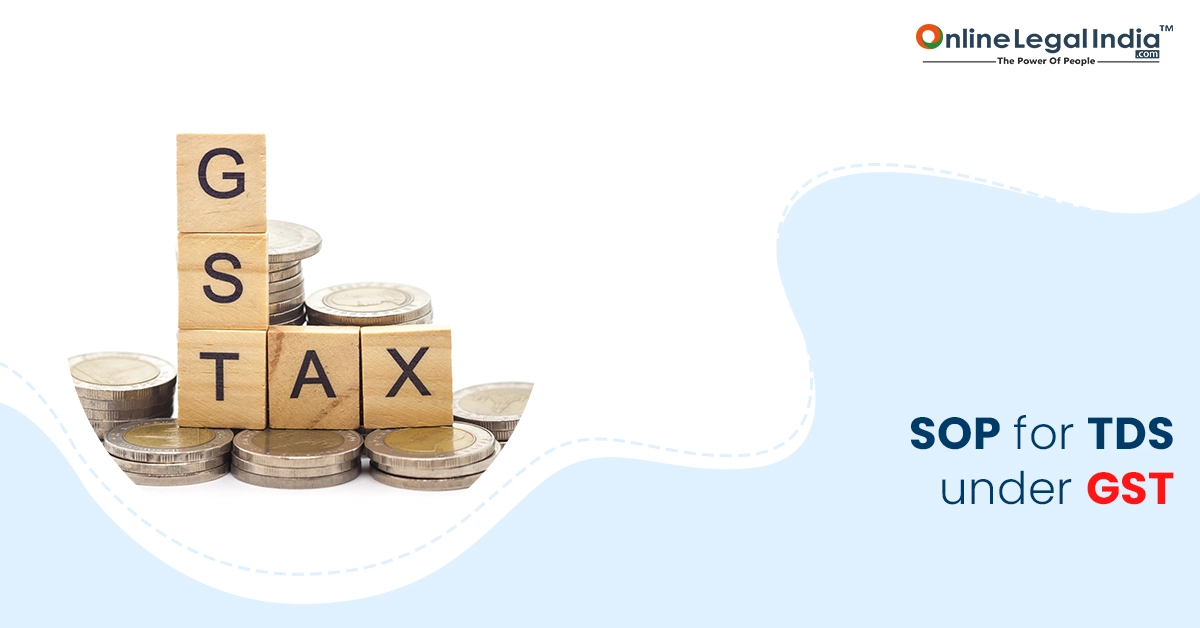Top ODR Platforms in India: Revolutionizing Digital Justice
21 Apr, 2025

 By Online Legal India
Published On 14 Mar 2023
Updated On 17 Feb 2025
Category GST
By Online Legal India
Published On 14 Mar 2023
Updated On 17 Feb 2025
Category GST
The Goods & Services Tax (GST) is an indirect tax system implemented in India to replace other indirect taxes and simplify the tax structure. Tax Deducted at Source (TDS) is a mechanism under the GST regime that shifts the obligation to pay tax from the beneficiary to the deductor.
The deductor is obligated to deduct tax & deposit it with the government at the time of payment to the supplier.
The CBIC issues SOP for TDS under GST to clarify different areas of application and process surrounding tax deduction at source under GST.
The GST Law compels some registered persons to deduct tax from payments to suppliers and deposit it with the government. Every registered person deducting TDS under GST must file a Form GSTR-7 return.
According to Section 7 of The CGST Act, SOP for TDS under GST includes products and services to government agencies and others mentioned under 'persons liable to deduct TDS under GST legislation'.
If the entire supply value under a specific contract for the delivery of taxable goods or services exceeds Rs.2,50,000, the designated people are obligated to deduct TDS. This amount does not include Central Tax, State Tax, UT Tax, Integrated Tax, or Cess. Read more
The SOP for TDS under GST stipulates that tax must be deducted if all of the following requirements are met:
The deductor must identify the supplier and assess whether the provider qualifies to deduct TDS. This may be accomplished by analysing the supplier's GST registration and determining whether or not they have a valid GSTIN number.
The deductor must compute the amount of TDS liability derived as a percentage of the supply's value. The TDS rate for goods is 2%, and the rate for services is 1%.
The TDS must be deducted from the amount payable to the supplier and set aside by the deductor. TDS must be credited to the government's account within 10 days after the month's end if it was deducted.
The deductor must provide the supplier with a TDS certificate as confirmation of the TDS deduction. The following details must be present on the certificate:
The TDS must be deposited with the government through the Electronic Cash Ledger by the deductor. The TDS deposit must be accompanied by a challan, which is a tax deposit form.
The deductor is required to file a TDS return with the government, which is a statement that includes information on the TDS deposited and the TDS certificates issued. The return must be filed within 10 days after the end of each month.
The SOP for TDS under GST elaborates on the situations in which TDS under GST is not required to be deducted.
The following are the advantages of Tax Deducted at Source (TDS) under the Goods and Services Tax (GST) regime:
TDS encourages GST compliance by shifting the obligation to pay Tax from the recipient to the deductor. However, to ensure timely compliance, the deductor must deduct tax at the moment of payment to the supplier and deposit it with the government.
Because the deductor is responsible for deducting tax at the source and depositing it with the government, TDS helps to reduce tax evasion. This makes it more difficult for suppliers to avoid paying taxes, which improves overall compliance with tax regulations.
TDS aids the government's cash flow by guaranteeing that tax is collected at the moment of payment to the provider. This aids in the reduction of tax arrears and the increase of government income.
The TDS regulations under GST are intended to be user-friendly, with a clear and simple method for deductors to follow. This makes it simple for deductors to comply with TDS regulations, lowering the administrative load.
The GST TDS provisions shift the obligation to pay tax from the recipient to the deductor. This decreases the recipient's tax burden and makes it easier for them to yield with tax rules.
TDS guarantees that tax is collected at the moment of payment to the supplier, improving tax transparency. This aids in the reduction of corruption and the improvement of accountability in tax administration.
The SOP for TDS under GST gives information about the GST GSTR-7 return.
Every registered TDS deductor must file an electronic return in FORM GSTR-7 by the 10th of the month following the month in which deductions were made. It can be submitted online or offline. Deductions made on or after October 1, 2018, but before the registration date, must be included in the first return filed following registration.
Tax paid via challan would be credited to the deductor's computerised cash ledger. Therefore, the deductor must fulfil his obligation by debiting his electronic cash ledger.
The deductor must give the deductee a system-generated certificate in FORM GSTR-7A detailing the contract value, rate of deduction, the amount deducted, the amount paid to the government, and so on. This certificate must be submitted within five days after crediting the amount thus deducted to the government, i.e. within five days of filing a FORM GSTR-7 return.
Upon filing Form GSTR-7, the amount deducted will be available in the registered deductee's Form GSTR-2A/4A and recorded in the electronic cash ledger. This cash can be used to pay down the deductee's tax responsibilities.
According to the SOP for TDS under GST, two scenarios generate late costs under TDS:
Conclusion
The SOP for TDS under GST provides a clear and straightforward approach for deductors to follow to comply with the TDS regulations under the GST system.
To avoid fines & ensure compliance with tax rules, deductors must understand and execute the SOP. By following the SOP, deductors may make the TDS process easier, faster, and less stressful.